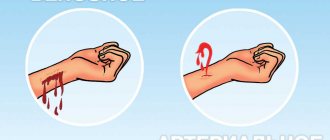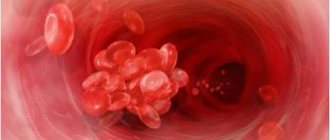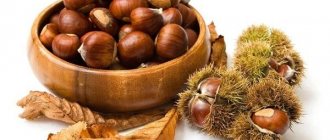How to stop bleeding from a finger?
The fact is that every housewife should have in her first aid kit:
- Hydrogen peroxide
- Iodine
- Bandage
- cotton wool
- Furacilin
- Tourniquet
- Plasters
- Cotton pads
After all, during an injury, there will be no way to bandage the wound if you don’t find the simplest dressing materials in the first aid kit. It is necessary to assess the depth of the cut. If the damage is caused by a knife, and it is shallow, then you need to put your finger under a stream of ice water for a couple of minutes. Next, using a cotton pad, squeeze your finger tightly and wait about 3 minutes. After this, the affected area is treated with an antiseptic. It could be iodine or hydrogen peroxide. Next, a bandage is applied and the finger is sealed with a plaster.
Pay attention to the sensitivity of the limb. If you feel that your finger does not bend so well, or there are any problems with sensitivity, be sure to consult a doctor. You may have damaged a tendon or nerve endings during your injury, which requires immediate surgery. To avoid the occurrence of abscesses, after the initial treatment with an antiseptic, after a while, when a crust appears on the surface of the damage, treat the area with peroxide again. Doctors do not recommend using iodine to stop blood flow, because the substance dries the skin and can cause cracks and itching in the area of damage.
Blood flows
General rules for stopping bleeding
General rules for helping a person with cuts or other injuries that are accompanied by bleeding include:
- applying a cold compress;
- applying a tight tourniquet;
- raise and bend the limb as much as possible;
- press the vessels with your fingers;
- press down on top with a rolled towel or clean cloth;
- washing the wound;
- applying a sterile dressing;
- washing the damaged area with an antiseptic solution;
- suturing in a medical facility.
How to stop bleeding from a finger with a deep cut?
You need to do things a little differently. The fact is that under the influence of a stream of ice water, blood may increase even more.
Instructions:
- Under no circumstances should you put your hand under a stream of ice water. The ideal option is to soak a cloth in cold water and apply it to your finger for a few minutes.
- Next, treatment is carried out with an antiseptic and a tight bandage is applied.
- You need to try to close the pieces of the wound to each other as close as possible. This will speed up the tightening and healing of the wound
If you work in the country, you should have a first aid kit, dressings and the simplest antiseptics with you. They will help stop and disinfect the damage.
Deep damage
Temporary events
It is important to know how to stop the bleeding temporarily until doctors arrive. This process consists of mechanical action on the damaged area. If the bleeding is temporarily stopped correctly, the patient's life can be saved. First you need to determine the source of external bleeding. Only after a temporary stop is it necessary to take the victim to a medical facility.
Temporary stopping methods include:
- applying pressure with a finger above the wound;
- bend the limb as much as possible to stop the flow of blood to the damaged area;
- raise a limb;
- apply a pressure bandage;
- tightly pack the damaged area;
- press the damaged vessel so that it stops bleeding;
- applying a tight tourniquet in case of bleeding.
How to stop bleeding from a finger when cut by glass?
The situation is complicated by the fact that there may be pieces of glass in the wound. Accordingly, you need to try to pull them out.
Instructions:
- This is done using tweezers. Do not try to widen the edges of the wound under any circumstances. This increases bleeding
- If you cannot cope, you need to apply a dressing and go to the hospital so that doctors can remove the glass from the wound
- If you don't do this, infection may set in and the wound may become infected.
- After you remove the glass, you must again try to close the edges of the wound, pulling them towards each other, and treat the damage with an antiseptic
Deep damage
Mistakes when stopping bleeding
Many people are interested in how to stop bleeding and not harm a person. It is important to avoid the following mistakes when providing assistance:
- Excessive movements, twitching of the victim.
- Attempts to straighten dislocations on your own.
- Inept application of a tourniquet.
- Tilt your head back to stop nosebleeds.
- Self-use of medications.
- Pouring the wound with alcohol solutions.
- Independent removal of foreign objects from the wound.
- Drinking alcoholic beverages for pain relief.
Before stopping the bleeding, you must call an ambulance. Only a specialist can determine the severity of the wound and prescribe qualified treatment.
How to stop blood from a finger if it is flowing and pulsating?
With deep damage, pulsation may be observed. This is due to the fact that you may have hit a blood vessel or a large capillary. This causes blood to flow in the same way as your heart beats. Stopping this type of bleeding is difficult.
Instructions:
- You need to take a wet and cold cloth, wrap it around your finger and raise your hand up so that it is above the level of your heart.
- This will reduce blood flow to the finger and it will gradually begin to flow more slowly.
- After the bleeding has stopped a little, it is necessary to pull the edges of the wound towards each other
- In this case, it is best to use very thin strips of adhesive tape.
- Cut them like noodles and stretch the edges of the wound from one side to the other
- This way you will be able to bring the edges of the skin as close as possible.
Affected area
Apply a tourniquet:
- An excellent option to stop bleeding is to apply a tourniquet. If you don't have one, a piece of cloth or bandage will do.
- It is necessary to tie a bandage tightly at the base of the finger. The criterion for how tightly to tie will be stopping the bleeding
- If this happens, then everything is fine. Remember that the time and duration of such a dressing should not be more than 2 hours in summer, and more than one hour in winter
- The fact is that if blood does not flow to the finger for a long period of time, tissue necrosis may begin.
- You risk being left without a phalanx or even the entire finger
Deep cut
Signs of bleeding
Bleeding symptoms and signs will directly depend on the severity of the injury, the presence of chronic pathologies, and the rate of blood clotting.
It will be possible to stop the bleeding only after correctly identifying the symptoms of the injury. All wounds are divided into the following types:
- chopped. Occurs when careless handling of a thin knife or awl. The diameter of the wound in this case is small, but the damage is deep, affecting the deep layers of tissue;
- narrow. Such damage occurs from a piece of glass;
- torn. They occur when struck with a blunt object, causing the epidermis to burst.
Symptoms can be bright and noticeable, or they can be hidden - to determine them you need to carry out certain diagnostics. It is important to be aware of the signs of bleeding so that you know how to stop it and provide the victim with proper first aid.
There are several states of severity of this symptom:
- Lung. In this case, a person loses up to half a liter of blood.
- Average. Loss of half a liter to a liter of blood.
- Heavy. Loss from 1 liter to one and a half liters.
- Massive. A person loses up to 2.5 liters. You need to stop the bleeding quickly.
- Lethal. More than 2.5 liters of fluid are lost.
Symptoms are related to the amount of loss. In the first degree, weakness, vertigo, and chills may be an addition. In an advanced situation, the following symptoms appear:
- interruptions in heart rate, breathing problems;
- weakness;
- a sharp drop in blood pressure;
- decrease in heart rate;
- loss of consciousness.
It is important to see a doctor quickly. He knows how to stop bleeding correctly and prevent the development of complications.
How can I stop bleeding from my finger when I get a cut if it doesn't stop?
It happens that due to strong pressure, or a deep cut, the blood flows and does not stop. This may be due to the person taking blood thinning medications. The bleeding should stop within 5 minutes. If this does not happen, action must be taken.
Adviсe:
- In case of deep damage, there is no need to put the damaged area under water and wash it
- You will need to apply a tourniquet or very tight bandage slightly above the area where the cut occurred.
- Raise your hand above your head and hold it for some time.
- In this position, blood will flow into the finger in a much smaller volume, which will provoke a blood stop and the appearance of a blood clot in this place
- As soon as a clot appears, there is no need to fill the wound with hydrogen peroxide. Because air bubbles can cause bleeding
- In this case, it is best to wrap a little cotton wool around a toothpick or use an ear stick
- Soak in iodine solution and lubricate the edges of the damage, bringing them as close as possible to each other
- Next, a sterile bandage is applied and the affected area is compressed.
Deep wound
Drugs to stop bleeding:
- Vikasol
- Vitamin P
- Epsilon-aminocaproic acid
- Medical gelatin
- Fibrinogen
- Trasylol
- Protamine sulfate
- Hemophobin
Affected areas
If the bleeding does not stop for more than 10 minutes, you must call an ambulance and go to the hospital. In such cases, an injection of hemostatic drugs is often given, which help improve blood clotting.
Causes of bleeding
The reasons are divided into two categories:
- traumatic;
- non-traumatic.
The first type is noted when there is mechanical damage to the integrity of the walls of blood vessels under the influence of external factors. Particularly severe bleeding occurs if the central veins or arteries are damaged, as well as if there are fractures of large bones. In some cases, the immediate loss is up to 2 liters. It is important to quickly provide proper medical care to the victim and stop the bleeding.
The second group is not associated with external damage. The reasons include:
- hemostasis disorders;
- pathological processes in the liver;
- dysfunction of the cardiac apparatus;
- diseases of the gastrointestinal tract;
- development of tumor processes;
- hypertension;
- diseases of the vascular system.
This type is usually difficult to diagnose, and treatment can be lengthy.
Further treatment
If it is possible to stop the bleeding from a wound and the wound no longer bleeds, it is necessary to take measures to prevent infection from entering it.
Medicines for cuts
Wounds and bleeding must be treated with a bactericidal drug. The most suitable means are the following:
- hydrogen peroxide, which will not cause pain in the victim, but will destroy the maximum number of germs and bacteria;
- iodine and its varieties, for example, Yox, Iodoform, etc.;
- a solution of brilliant green, or brilliant green, which can now be purchased in the form of a pencil or powder;
- a solution of potassium permanganate, which effectively disinfects bleeding wounds;
- Furacilin tablets, which must first be dissolved in water;
- an alcohol-containing liquid, for example, vodka or cologne, however, the patient will experience painful sensations in the form of a burning sensation;
- Vishnevsky ointment, which is used when there is pus in the wound.
If the measures taken have had the desired effect, and the wound after the cut begins to heal, it still requires close monitoring for 1-2 days. If the affected area is red or swollen, it means that an infection has occurred, so you should immediately consult a doctor. Bleeding may start again, it must be stopped, and then seek help from a specialist. The same should be done if there is a violation in the motor skills of the fingers. This indicates that the tendon has been damaged.
Folk remedies
Many plants have bactericidal, hemostatic and anti-inflammatory effects. At home, stopping bleeding is possible using the following means:
- Plantain. You should thoroughly wash the plant leaf, soften it with a rolling pin, and then apply it to the damaged area.
- Calendula. Bleeding from a wound can be stopped with a decoction of calendula flowers. It has an antiseptic effect and is used in the treatment of purulent inflammations and ulcers. Use the product in the form of lotions.
- Nettle. Tinctures are made from the pungent herb and are used to treat injuries with severe bleeding.
- Egg film. If you don’t have any bactericidal agents on hand and the cut is deep, you can use an egg. To do this, remove the part that is adjacent to the shell and represents a thin film. It is applied to the cut site, which stops the bleeding.
- Aloe. You need to take the largest leaf of the plant, cut it along its entire length so that it is as wide as possible. The sheet is applied to the wound with a cut, after which the damaged part is bandaged.
Important information: Why does scarlet blood flow from the anus (butt) during bowel movements in women (men) and what adults should do to treat heavy bleeding
Treatment should be done carefully so as not to cause increased bleeding.
The use of traditional hemostatic agents
In folk medicine there are enough recipes that will help stop bleeding after a cut and get rid of the symptoms of inflammation. The most popular folk remedies for stopping bleeding :
- A decoction of oak bark is used to stop bleeding from a finger. It has astringent properties that stop bleeding. This decoction is used to wash the cut, and bandages are also made with napkins soaked in this solution,
- Calendula decoction helps disinfect the wound. A small piece of bandage or a sterile napkin should be moistened in this decoction and applied to the wound surface. Secure the napkin securely with a bandage,
- Plantain leaf has long been used for various cuts and abrasions. The sheet must be washed, dried and slightly crushed with your hands or a rolling pin. Apply the leaf to the wound,
- Aloe pulp can be used to stop bleeding from cuts. Wash the aloe leaf and cut it lengthwise. Apply the cut to the wound and apply a tight bandage over the sheet.










